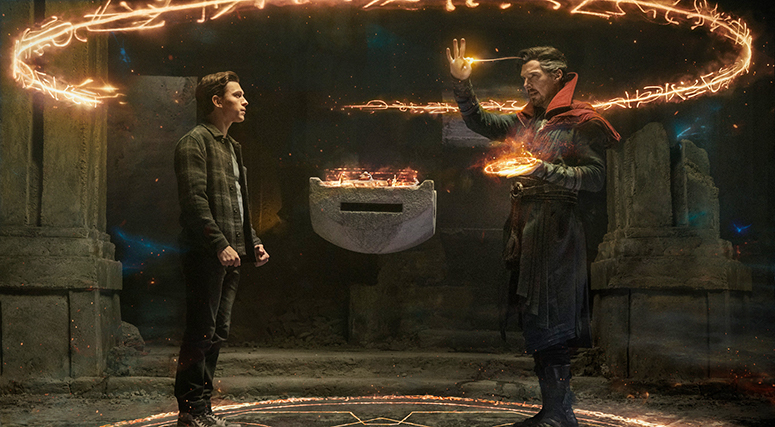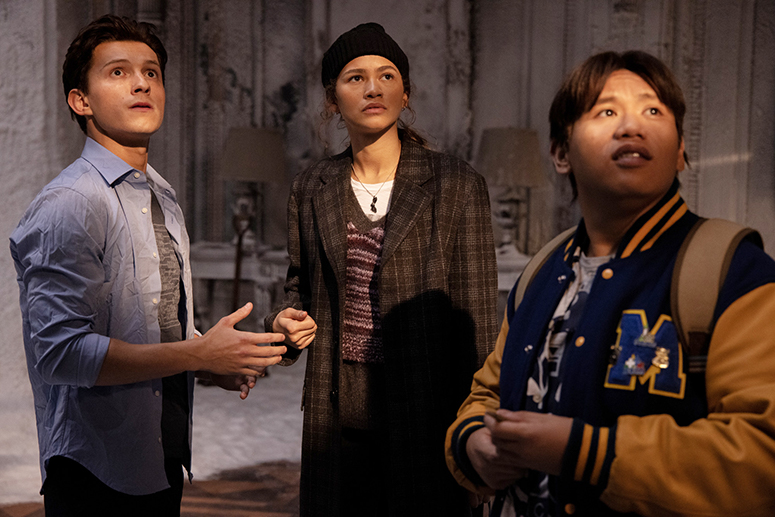Spidey’s identity crisis
Spider-Man: No Way Home—the long-awaited final entry in the “Homecoming” trilogy starring Tom Holland—is full of surprises and laughs. But for me, watching with a carefully distanced set of media peeps at The Block, North SM EDSA, the bit that connected most viscerally was when Ned (Fil-Am Jacob Batalon) has to smooth things over with his Lola when she discovers a webbed guy hanging from her sala ceiling.
She instructs the costume-wearing Peter Parker to remove some nasty spider webs over in the corner while he’s up there. In Tagalog! With no subtitles! The sudden, unexpected plunge down a friendly spiderhole into the local vernacular was priceless. It was a moment of immediate connection and the Filipino audience hooted and applauded.
It goes to show that, more and more, as the world movie audience grows bigger and more diverse, the superhero world is expanding its cultural references. And that’s a good thing.

Another good thing: this is the third in a trilogy starring Holland as Peter Parker/ Spidey, and usually that wraps things up for each actor who dons the costume. We’ve come to expect periodic superhero reboots as pretty much the norm—from seeing Batman morph from Keaton to Clooney to Bale to Affleck—and so it goes with Spider-Man, who now exists in three separate storylines headed by three actors.
But wait... Who says they have to be separate?
In No Way Home, the concepts raised in the clever Spider-Man: Into the Spider-Verse (itself expanding to present an African-American Spider-Man) come to full fruition, and everything just multiplies like crazy.

That animated interlude was radical and excellent in many ways, but it also successfully teed up this latest entry, with Holland, Zendaya (MJ) and Batalon going full multiverse thanks to an identity slip at the tail end of Spider-Man: Far From Home—that is, Spider-Man being unveiled to the world as Peter Parker.
A lot about Spider-Man: No Way Home is like taking a plunge down the spiderhole into new dimensions. But it’s also a returning of sorts, and a reunion. Villains from past movies turn up (won’t spoil any further), as do heroes. Doctor Strange drops in (floats in, more like) to not only help an anguished Parker (seems being outed as Spider-Man creates multiple problems), but to help segue into his own upcoming MCU film, which bears the unwieldy title Doctor Strange in the Multiverse of Madness.
Even Sony and Disney, which co-released the film, are allowed to cross over crazily in the world of Spider-Man, which is a hoot for viewers who love meta jokes. (One character outside of the Marvel Cinematic Universe says “The Avengers? Who’s that?” when Parker drops his past credentials into the convo.)
It seems Peter wants to do a version of It’s a Wonderful Life and reset everyone’s memory back to not knowing that he’s Spider-Man. You’d think he’d know by now that this kind of thing is fraught with danger; but no, Peter convinces an exasperated Doctor Strange (Benedict Cumberbatch) to wave around his hands and make with the floating fire thingy.

Next thing you know, visitors are dropping in from other timelines in the multiverse, keeping things busy for MJ, Ned and Peter.
As with the previous Holland-led outings, this Spider-Man is young, hip, full of zippy lines and meta situations. In its way, the trilogy is allowed to zoom out much further than the ones starring Tobey Maguire and Andrew Garfield; it takes in the whole expanse of this world, allowing ironic commentary on all of our expectations of Spider-Man, past and present.
It’s mind-expanding, to be sure. But it can also be a bit sloggy at times, with a length of 148 minutes and teaser trailers to spare. The action sequences blow up to the expected Marvel supersized dimensions, which tend to cast a certain CGI glaze over this viewer’s eyes. That said, the young trio is still appealing, though MJ has less and less to do here as the love interest (not much problem-solving, either) while Ned, the perennial “guy in the chair,” gets to take his act on the road.

In the “Homecoming” trilogy, a lot of attention is paid to identity and origins. Peter Parker is (literally) a kid who was ripped from his concept of permanence into a sequence of fast-spinning adventures, palling up with Tony Stark and the Avengers a few movies back, and now finding himself under the mentoring care of a reluctant Doctor Strange and Happy Hogan (Jon Favreau).
As with previous outings, there’s a not-so-hidden political message in the script (by Chris McKenna and Erik Sommers). While the last film featured Jake Gyllenhaal as Beck/Mysterio, peddling “fake news” to worm his way into the Avengers, this one takes on those folks who, um, reject vaccinations because they prefer being monsters. So, pretty on the nose, metaphor-wise.
Also, public opinion is so hopelessly divisive in Far From Home that people can’t agree on whether Spider-Man is a good guy or a menace. So there’s that. Welcome to our current fractured multiverse!
There is a lot more room to explore emotional connections in Far From Home, though not so much between MJ and Parker and Ned, whose teen troubles are well established and mostly kept in the background here, as the connections between Parker… and Parker…. and Parker. (Medium-strong hint.)
It is surely a gas and a hoot to see so much cameo firepower stuffed into the biggest-grossing Spider-Man yet, though it kind of reminds me of those old Universal monster movies that managed to stuff in Dracula, Frankenstein, the Wolfman and Abbott and Costello into one plotline. (Also a little like those Saturday Night Live episodes that have so many cool actor cameos that you completely forget how spotty the writing is.)
Still, Spider-Man: No Way Home is a class act, and it brings this Spidey full circle. A lot of pain and heartbreak, a lot of feels, a bit of fan-servicing for Tagalog fans (a lot of that record box office comes from Asia, I’d wager), and a hint that, for Peter Parker, the place he calls “home” is really his familiar old neighborhood, after all.



